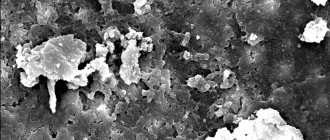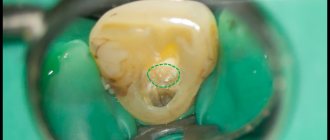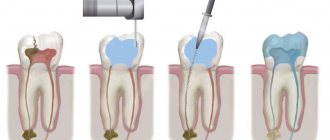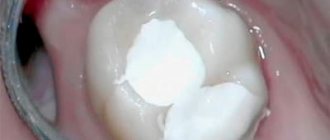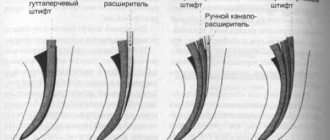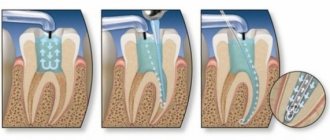What are root canals
The dental nerve, or pulp, is located not only inside the tooth, its crown, but also inside the roots. Root canals are elongated cavities located inside the roots of teeth. This is where the dental nerve passes within the root. The number of root canals in one root may vary. There may be two or more channels in one root. The root canal can be very thin, thinner than a human hair, so high-quality treatment can take quite a long time. The difficulty is that even with the use of modern microscopes, the doctor cannot see absolutely all parts of the root canal. Work in the deepest part of the root is carried out almost blindly, which requires experience and skill from the doctor.
TREATMENT OF TOOTH CANALS – A LITTLE ANATOMY
If you look carefully at the photo below, you can see a narrow cavity that runs along the entire length of the tooth root. This cavity is not empty - inside it there are soft tissues of different types: nervous, connective, circulatory and lymphatic. The cavity with tissues is the dental canal, which can sometimes have small branches or other structural anomalies.
During root canal treatment, the doctor removes the pulp tissue, but there is no need to be afraid of the negative consequences of this procedure. Pulp tissue plays a key role in childhood, when the process of active development of incisors and molars is underway; in an adult, pulp tissue is solely responsible for tooth sensitivity. If canal treatment is carried out professionally and the inflammation in the root cavity can be eliminated, then you will not feel the difference between a living and a “dead” tooth.
Root canal treatment
Root canal treatment takes place in several stages. Before treatment, X-rays or computed tomography must be taken. Using CT or X-ray images, the doctor will determine the approximate length of the root canals, shape, and the presence of obstacles to their cleaning.
Preparation for root canal treatment involves administering anesthesia and isolating the tooth from saliva using a rubber dam. If a tooth is severely damaged, the doctor can first restore its walls using temporary filling material.
MATERIALS FOR FILLING DENTAL CANALS
The choice of materials for canal filling is the most important stage of treatment. The composite must firmly seal the root cavity and retain its structure for as long as possible.
Traditionally, thermogutta-percha is used to fill root cavities, which, when hardened, tightly blocks the dental canal and at the same time accurately repeats its shape. The material fills all pores and cracks in the canal, does not cause periodontal irritation and does not cause darkening of the natural enamel layer of the teeth.
Other materials and techniques can be used to fill the canals; the specific method is selected by the dentist after examining the patient, carrying out diagnostic measures and radiographic examination.
Cleaning and expansion of root canals
Root canal cleaning begins with measuring its length. A special instrument that resembles a needle in appearance is inserted into the root canal. A special apparatus is attached to this instrument - an apex locator. When the root apex is reached, the device beeps and the distance to the apex appears on its display.
After measuring the length, the doctor begins to clean the canal from the remnants of the nerve and expands it. Root canals can be expanded using hand instruments that the doctor holds in his hands or using machine or rotary instruments. Rotary instruments are inserted into a special tip - an endomotor. Development with machine tools is more modern and more expensive. It speeds up the process and provides higher quality processing. In order for a doctor to achieve a similar effect using hand instruments, the doctor will need much more time. After each insertion of each instrument, the doctor rinses the root canal with a chlorine-containing antiseptic.
After processing and drying the root canal, it is filled.
Measles canal filling
The procedure for filling root canals is carried out in various ways, for example: by the method of cold lateral (side) condensation of gutta-percha pins (reliable and affordable). Pins that resemble gutta-percha sticks in appearance are inserted into the root canal. After insertion, these sticks are compacted against one of the walls of the root canal. Between the gutta-percha there is a special paste for filling the canals.
The most modern method is filling the root canals using the vertical condensation method of hot gutta-percha. With this method, the doctor seals the top of the root canal using a heated gutta-percha pin. After this, the remaining volume is filled with hot liquid gutta-percha. This method is more expensive.
After the filling, if everything is done well, the doctor removes excess gutta-percha and sealer, and then installs a temporary filling. X-ray control is required. Permanent tooth filling in one visit is carried out only in exceptional cases, since it is necessary for the material to cool completely.
After root canal filling, discomfort may persist for some time. The tooth may be sensitive when biting. Within a few days the pain goes away.
The main stages on which the quality of root canal filling depends:
1) Determination of the working length of each root canal -
High-quality root canal treatment requires that the root canals be filled to the apex of the root. If the channel length is determined incorrectly, then there are 2 options :
- The root canal will be underfilled - this will lead to inflammatory complications, the development of periodontitis, cysts, and in the absence of retreatment of the tooth - to its removal.
- The root canal will be refilled - the filling material will be excessively removed beyond the apex of the root, and this can lead to long-term pain, neuralgia, and the development of inflammation.
Therefore, it is necessary to carefully measure the length of each canal in the tooth. This is done in good clinics as follows: after removing the pulp from the root canals, the doctor, using special thin hand instruments (for example, K-files - Fig. 7, 10) tries to go through each root canal to the apex.
The advancement of the instrument deep into the canal is carried out under the control of a special device “apex locator” (Fig. 6), which is connected with the help of an electrode to the K-file located in the canal (Fig. 7-8). The display of the apex locator reflects the depth of the instrument's immersion, as well as the moment the instrument tip reaches the root apex.
Important: the apex locator only shows an approximately accurate picture. Therefore, after measuring the length of the canal with an apex locator, the K-file is left in the root canal and the patient is sent for an x-ray. These K-files are radiopaque, so the X-ray can clearly see whether the tip of the instrument has reached the apex of the root.
2) Mechanical treatment of root canals –
The purpose of mechanical treatment is to expand the root canal and make it suitable for filling.
Untreated canals in most cases are very narrow, have many imperceptible narrowings and expansions, which will not allow the canal to be properly filled with filling material along its entire length. Thus, mechanical treatment should remove all narrowings and irregularities throughout the root canal, and expand it to a certain size.
There are 2 methods of mechanical treatment of root canals:
- Hand instruments (Fig. 10) - the doctor rotates such instruments in the root canal with his fingertips. Below you can see photos and videos of this method.
- Using an endodontic tip (Fig. 11) - special Pro-files made of nickel-titanium are inserted into such tips (Fig. 12). The endodontic tip rotates the profile in the root canal, as a result of which the sharp edges of the profile remove chips from the walls of the canal, expanding it. Due to the fact that the metal of the profiles has a shape memory effect, they do not break during rotation even in highly curved root canals.
The advantages of processing canals with such machine Pro-files over hand tools:
- The quality of canal treatment is many times higher - the surface of the root canal walls after such treatment is very smooth, as if polished, and this facilitates the insertion of gutta-percha pins for filling the canal. In addition, the use of an endodontic tip can significantly reduce the processing time of canals (compared to manual processing).
- Safety - in most cases, the endodontic handpiece comes complete with a smart micromotor (Fig. 11), which controls the movement of the file in the canal.
If a certain load is exceeded, which threatens to break the profile in the channel, the micromotor stops the rotation of the profile and turns on auto reverse. Therefore, the threat of the tool tip breaking off in this case is minimal, which cannot be said about manual files. After all, the doctor’s fingers, with which he rotates the “manual” file, feel quite weakly the extreme resistance to the movement of the instrument, after which the instrument breaks off in the canal. If your clinic performs mechanical treatment of canals using such smart devices, this is a big plus. However, it is worth remembering that in any case such treatment is performed by a doctor, and even the smartest and best device in the wrong hands can cause more harm than good (24stoma.ru).
Mechanical treatment of canals with hand instruments and endodontic handpiece: video
3) Filling root canals with gutta-percha –
After the root canals have been expanded and the root canals have been treated with medication, they need to be sealed. Root canal filling methods that can be used in dental clinics:
- One paste method - the canal lumen is filled with a plastic material, which then hardens. At the moment, there is no more terrible method of filling canals; complications develop in almost 99% of cases. If your doctor fills your canals in this way, then you need to run urgently! And if you can’t run, then you should at least crawl to the exit.
- Single pin method - after filling the root canal with paste (as in the previous version), one gutta-percha pin is inserted into the root canal. This method is slightly better than the first, however, the percentage of complications after such treatment is also close to 99%, and you also need to run.
- Method of lethal condensation of cold gutta-percha - the meaning of this method is to compact the pins of cold gutta-percha as tightly as possible along the entire length of each of the root canals. We will discuss this method in more detail below. The method has an affordable cost and high reliability.
- Vertical condensation of hot gutta-percha is the most effective method of filling canals, which is carried out using gutta-percha heated to a fluid state.
The latter then gradually cools and hardens. Due to the fact that at the beginning it is in a fluid state, gutta-percha flows even into the lateral microchannels, which cannot be sealed by any other method (even the lateral condensation method). There are many techniques for using this method and materials for it. However, the best system for filling canals with hot gutta-percha called Termafil. If you are willing to pay for quality and reliability, then this is your method. But be prepared for the fact that the cost of filling canals with Termafil will be high.
Video: filling canals with cold and hot gutta-percha
How to understand whether the root canal is filled properly
Signs of a properly treated canal are visible on x-ray: filling to the tops of the root, dense filling of the canal without any excess or voids. It is not desirable to have material residues outside the root canal. If the paste does not dissolve, an inflammatory process may develop in the future. But the quality of work depends not only on the attending physician: the patient himself also plays an important role. By following all the dentist’s recommendations, observing the rules of oral hygiene, as well as a careful approach to the health of your teeth, this is the only way you can achieve the desired results.
Root canal treatment and filling should always be trusted only to experienced specialists. An experienced dentist in Minsk is waiting for you at the Family Dentistry Center. Comfortable treatment, modern equipment of European quality, highly qualified specialists and an individual approach to each patient. Thanks to the use of drug sedation, all procedures can be performed without stress and pain, and children's fears of the dental office will go away on their own.
HOW TO DETERMINE THAT TOOTH CANAL NEEDS TREATMENT
The need for dental canal treatment is determined only by a qualified specialist - a dentist and after a thorough examination of the oral cavity. Make an appointment with our dentistry in Moscow at the slightest manifestation of toothache; also, do not delay a visit to the dentist if you experience swelling on the gum or other discomfort in the tooth and gum area.
It is worth knowing that sometimes an infection that has entered the dental canal may not manifest itself in any way. Pulp tissue can die asymptomatically, and in such cases, only a visit to the doctor can determine the need for urgent treatment of root cavities. Traditionally, radiographic examination is used to diagnose canal infection.
Tooth canal treatment
from 2000 rub. More about prices
We have been working since 1994
we are one of the first to open private dentistry in Moscow
Best materials
only new and modern equipment for dental treatment
Free
consultation with a dentist
Payment options
- cash
- plastic cards
- cashless payments
Doctors' experience
- with great experience
- graduated
- conference participants
The main indications for dental canal therapy are:
- 1. Trauma or active inflammatory process in the nerve tissues of the tooth.
- 2. The appearance of a special type of neoplasm on the gums - fistulous tracts, which outwardly resemble pimples.
- 3. Fractures and dental root injuries.
If you are suffering from throbbing pain, you notice a swelling on the gum, darkening of the tooth crown - contact our dentistry in Moscow - Vanstom for consultation and treatment. The clinic’s specialists will be able to quickly alleviate your condition and provide high-quality dental canal treatment.

